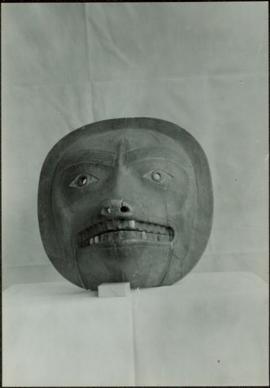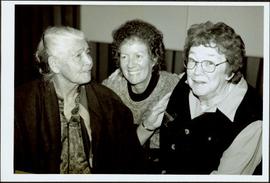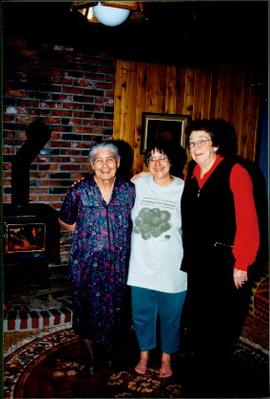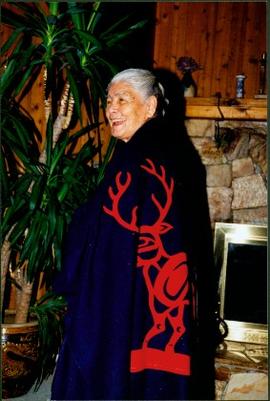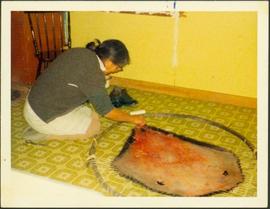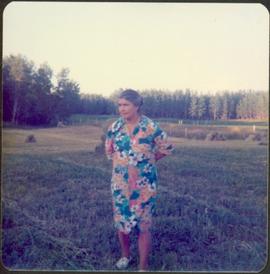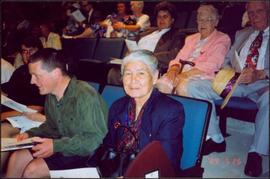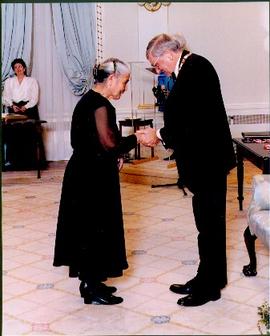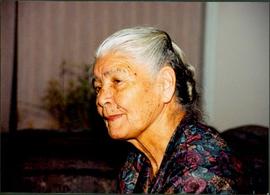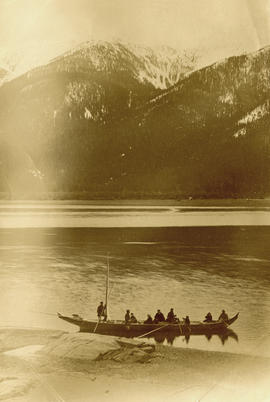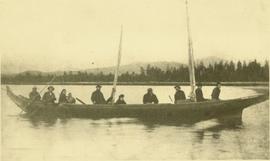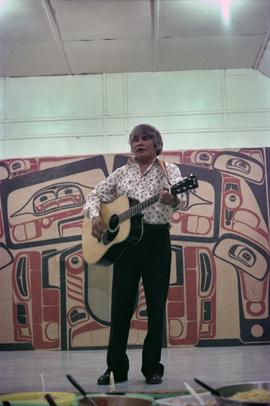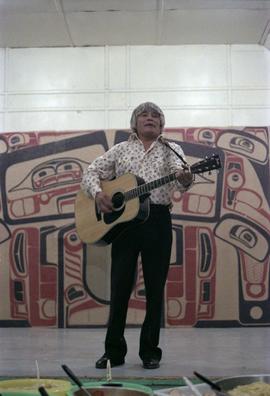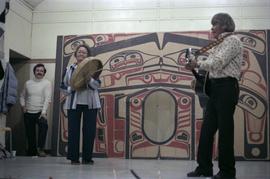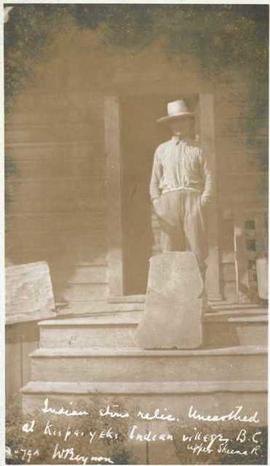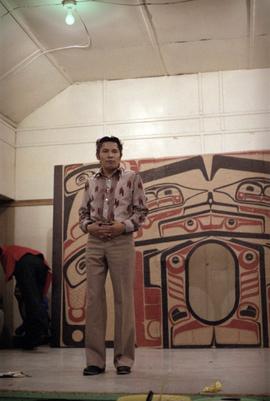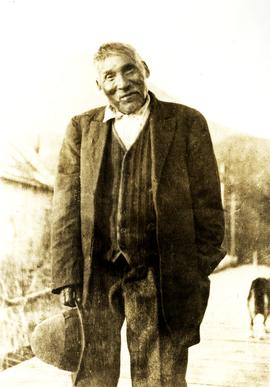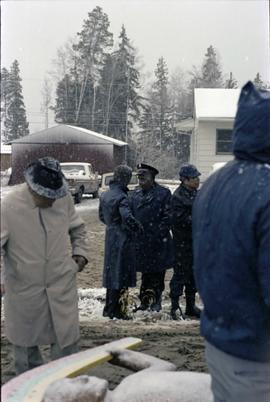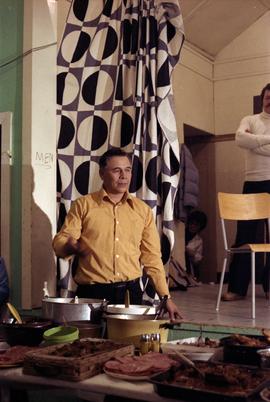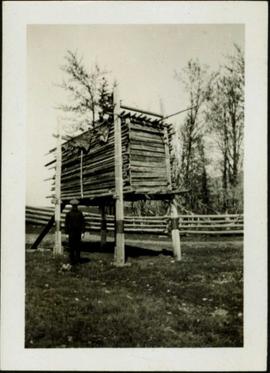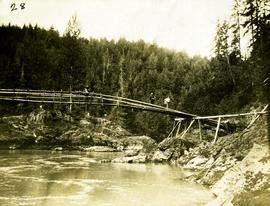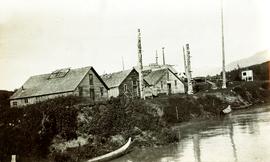Carved wooden mask featuring inlaid teeth and a halo surrounding the face. Stamped annotation on verso reads: “Department of Mines and Resources, Photographic Section. Oct. 6, 1939”. Numeric annotation on verso: “44-5”
Close view of three women at unidentified location. Left to right: John, Hope, Moran.
Unidentified woman stands between Mary John (on left) and Bridget Moran. Fireplace in background.
Photograph depicts Mary John wearing long blue material with red caribou in traditional artwork on back. Plant and ornamented fireplace in background. Photo speculated to have been taken in Mary John's home.
Audio recording consists of an interview conducted by Bridget Moran with Mary John.
Audiocassette Summary
Context: Recording is the continuation of earlier sessions by Bridget and Mary John talking about her life – appears to continue on from the other tape sessions numbered to #8 [Accession # 2008.3.1.211.4]
Side 1: “Mary John #9”
0’05” Bridget interviews Mary John and asks about Mary John’s grandmother who lived at the reserve at Fort George. Mary notes that her grandmother was sent back to Fort George and then to Stoney Creek after husband died. Her Grandmother remarried; she died in the 1950s. Mary talks about her grandmother’s marriage with Za (Jean) Paul – that was not an arranged marriage; her Grandmother “she had a hard life”
4’00” – 7’30” Mary Johns’ mother married Johnny Paul – not arranged; Mary notes that she was born in Fort George. Mary lived with her Grandmother Ann on reserve in Fort George. Mary then talks about her sister Bella – who married Mike Ketlo (sp?) and their children. She died of tuberculosis in the 1950s.
7’40” Bridget asks about the Mission School in Fort St. James – near the church “that is on Mission land” Which is where the village originally started. They talk about the church’s history briefly.
9’00”-14’00” Bridget asks Mary about her schooling at Lejac – Mary says they had reading, writing, arithmetic, penmanship and history. There was no science taught. Mary then describes the routine at Lejac. Doing chores and then breakfast at about 7:30 and then did cleaning chores in the dormitories. Then they attended their classes; then lunch, then played outside and then came back for sewing or embroidery, knitting and then back in classes until 4:00pm. Mary describes recreation – swimming, playing in the field, chores – pulling roots/stumps etc. Bridget talks about Joanne (Fiske?) thesis on the distinction between native boys and native girls’ activities and education at the residential school and that it enabled them to go to work in the hospitals and offices but that the farming education that was taught to the boys didn’t help them as there was no agriculture on the reserves. Mary notes she was ‘teachers pet’ as she had music lessons for singing. Mary notes she didn’t do anything in the kitchen but took mail to the post office and looking after the office for the Mother Superior. She feels she learned ‘the basics’ [but] then they ‘kicked you out at 16’
15’00” Bridget asks about the differences in disciplining methods of children – she notes that it is not part of Indian culture to spank children. She notes it is part of her husband’s sisters to discipline her children – not her or her husband’s duty
17’00” Mary talks about the residents at Stoney Creek who objected to school at Lejac because of harsh disciplinary methods used with their children
18’00” Mary talks briefly about the food at Lejac and speaks briefly to another unidentified woman [Sabrina?] in the room about food preparation [canning?]
19’50” Bridget asks about the Stoney Creek residents who wanted to have a school at the village in the 1950s and wanted their children to go to school there.
20’00” Mary speaks briefly about Father Coccola and that he did the negotiation about the move of the people from the reserve at Fort George to Shelley and about some compensation acquired by the residents. Bridget notes he ‘did not do a favour to the Indians’ – Mary notes that they were forced to leave ‘very illegal’
22’00” Mary speaks again about Father Coccola who could be ‘a very strict man’ but who took care of the people when they were sick and dying
23’00” Mary talks about another priest (unidentified) that she really liked who gave her a job c.1935 when she and her husband cleared land for Lejac and the priest treated them really well. She thinks he was from the Yukon as he had gold nuggets
25’00” Mary talks about her children going to Lejac in the 1950’s
26’00” Bridget talks about a social worker who came to Stoney Creek in c.1955 and Bridget was asked to come out by the Indian Agent to investigate what was the issue. This social worker was scared of being on the reserve; Mary thinks this woman had marital problems and drank a lot
28’00” Mary talks about the Day school operating c.1951 for a short time and the kids were bussed back and forth; other kids ‘orphans’ went to Lejac (lived there)
Tape is poor after this; noise with squeals and recording is faster
29’00” Mary talks about her children (Helen and the boys) not liking Lejac. She notes that one of the boys didn’t like it ‘but didn’t complain’ about it. She notes that ‘no one would talk about it’ “the whole village would be silent” when they left; and the children would be crying.
30’00”-33’00” Bridget asks Mary to discuss her wedding in more detail – Bridget notes that she already has on tape about the wedding night itself but asks for more information about the wedding day. Mary begins to talk about the wedding; there was a Mass, the guests and there was a band….
Tape is unintelligible after this; recording is broken up with interference and then there is no recording End of side 1
Side 2 “Mary John #10”
This side of the cassette has no recording
Audio recording consists of an interview conducted by Bridget Moran with Mary John.
Audiocassette Summary
Side 1
0’02” Improvements within the Department of Indian Affairs; she notes that Indian Affairs was tricking the band. The Indian Agent took a logging contract away from Mary John’s son Ernie because he refused to pay the rate that they wanted in stumpage fees
4’00” Mary John recalls when the community started to speak up against Department of Indian Affairs about 1942. She recalls the Elders Society and the Indian Homemakers Association. She explains that the Elders Society supports the preservation of the Indian culture and arts/crafts; which involves set up of activities including summer camps; showing youths how to use fishing and hunting tools and recreation tools. Bridget asks about Elders involved in the Society.
13’00” Mary talks about teaching Indian language at the school for the youths and also teaching previously in the village for the children yet none of the children continue to speak their language today. But now with parents speaking at home it’s difficult to have them continue to speak their language
16’00” Bridget asks Mary to recall the time when she was named Citizen of the Year in Vanderhoof in 1978. Mary shows Bridget the award and recalls that they ‘had a big dinner’ for her. Mary notes it was a surprise, Mrs. Campbell brought her there – Mary John recalls that she didn’t have a speech planned
19’00” Bridget asks her to explain about the tanning of hides. Mary explains the process from the time of the shooting of the moose; fleshing and scraping of the hide. She explains how to use the knife on the hide so you can see the tissues of the skin. Then Mary turns over the hide to the hair side and shaves off the hair on the hide and then shows Bridget how it is scraped. They discuss the blade and how it is sharp. She explains it is then washed many times to clean the blood off and then it is stretched. She explains it is then spread with oil/ possibly fish oil – the whole hide is oiled up and then left about a week to dry. Then once dry you use another scraper to ensure it is soft. She notes it is a lot of hard work and time to complete. They then talk about smoking of the hides and Mary shows Bridget hides that she had made herself. Mary explains that the Elders have a class for the youths to show them how to tan hides.
29’00” Bridget asks Mary about the last potlatch held. Mary explains what a potlatch is and when it is viewed as a pay-out. A potlatch is thrown to pay back another clan for a service or a kindness that was done to them. She talks about potlatches for deceased persons; and how clans host potlatches. She talks about the foods prepared at a potlatch. Mary recalls “it can cost thousands of dollars” and notes plans in progress for the next potlatch to be held in August in Stoney Creek.
36’00” Recalls when potlatches were made illegal – recalls gifts she received years before at potlatches and ‘that someone benefits from it’ Years ago hides and dried goods were given out. Potlatches started up again in about 1934 and they held a potlatch for her mother when she died.
40’00” Mary explains there are two clans at Stoney Creek – the Frog and the Grouse; she explains that you don’t marry within your own clan.
45’00” Recalls the death of some of her relatives
End of Side 1
Side 2
45’02” Mary talks about her siblings who are still alive
48’00” Talks about the preparation and setting of nets in canoes for fishing
52’00” notes people like to be called native – not Indian
52’30” Bridget asks Mary what she thinks that has changed that is good? She thinks that the good things are better homes, electricity, cars, education, transportation and better roads. She fears there isn’t as much closeness as there was years ago among families – now people sit at home and watch TV. “People use to do things together – they don’t anymore.” Mary points out that another good thing is that people now get pensions.
56’00 Mary John speaks about her sewing business that she now has and the making of mukluks and moccasins
57’00 Bridget recalls bringing her Mother to Stoney Creek Reserve c.1954 and her mother noting her poor life in Ireland and recalling the poor people she saw on the reserve at that time and telling Bridget she had to help those people
59’00 they both refer to poor services done by the Department of Indian Affairs in the 1950s
End of tape
Audio recording consists of an interview conducted by Bridget Moran with Mary John.
Audiocassette Summary
Scope and Content: Tape recording is an interview between Bridget Moran and Mary John – a continuation of interviews.
Side 1
0’02” Bridget asks Mary when she quit smoking - in 1972
1’00” Mary notes there was no talk of sex life; not part of First Nations culture
2’00” Mary talks about when she started working at the hospital; she was able to save money and her husband drove her back and forth; lived in a tent to save money; they pumped water to drink from a well 1 mile away so that they did not get sick; she notes she began working at hospital after her husband lost his seasonal job
5’00” Mary notes they had to have a tribunal hearing to get old age pension for her husband because his birth was not registered
7’00” Mary recalls that the Depression did not hit reserves as hard as white people because ‘they had always been poor’; yet at that time they were never without food. She talks about tough times during the Depression – could not find work only relief; got used clothing from white people
10’00” Mary refers to a Mrs. Campbell, a white woman who was a widow and had small children who was also poor in the Depression and showed her how to repair socks
12’00” She notes that they did not have much of a relationship with the Indian Agent – they knew he existed but they did not see him much; viewed him as a representative for the Indians; some [of the Indian Agents] were good and some were bad; she describes difficulties with the Indian Agent and getting little food: only a single ration (24 bag of flour; 5 lb bag of rice, bag of salt; ½ lb tea and 2 lbs lard) to last a family for a month and also flannelette material to make bed clothes. Indian Agent Office was in Vanderhoof
17’00” Mary recalls that the watchmen quit in the 40s – that is when marriages stopped being arranged; there were no Band Managers then; that only ‘started recently’
19’00” Mary talks about the priest who lived on the reserve in the 1940s; she does not know whether the [Catholic] Church was good for her people. Does not think that the Catholic Church was good for Indian Culture – they were the ones that ‘took it away’ […] tried to beat it out of the children
24’00” She notes that since that time she has been asked to teach dancing and classes in Indian culture; notes that some children can speak “Indian” in Mary’s family; notes her children can speak their own language
27’00” Mary talks about when the residential school Lejac closed; that it was taken over by the Department of DIA
29’00” Mary sees ‘Alcohol as the worst problem among First Nation’ – she recalls that a group of them began to get together to ‘pray and work with people who needed the most help’; she notes that while native people were not allowed to buy alcohol before and now have the right to get it - it has since become a problem; she describes the effect of alcohol on the community. She notes that although she and her husband did drink at one time she doesn’t anymore and recognized it as a problem back in the 1950s. She describes her feelings after a nephew was killed in an alcohol-related accident and how this convinced her to quit drinking; it was a choice she made on her own
40’00” Talks about early years when they were married and how difficult life was at that time; she recalls going to see the children at Lejac and camping out to visit them; she describes how to make a camp with spruce boughs and bringing food to camp
45’00” Describes the furniture and stove they had in their house when Ernie (son) was born A lot of time spent with one another for recreation
(Continuation on side B – labeled as #6)
Side 2
48’00” Mary John talks about the church priest – would not come out every Sunday for Mass – only started recently having mass frequently; talks about the hospital where nuns worked;
56’00” Bridget asks her about recreation on the reserve; Mary talks about clothing used on sports team – played Stellako and other reserves; “Baseball was popular” – hardball; she recalls going to Prince George to watch ball tournaments
60’00” Discusses recreation in early years; would have dances at people’s houses
62’00” Mary discusses white-native relations; ‘we never talked about it’ there were white people who were ‘good people’ that she did work for; cases of racial tensions in Vanderhoof
67’00” Bridget asks her if any white people ever came to visit her home; Mary notes that none came out to the reserve – the only one that use to come out was the priest and remembers the priest eating breakfast at her home. But “Prince George wasn’t like that” She tells of racist comments even now that she experienced with a new doctor in town
End of session – tape ends temporarily Start up of session again
74’00” Mary John talks about their efforts to educate and pass on their culture to younger generations; they now teach survival in the bush. She explains that this is to get native youths to experience being in the bush and teach them how to prepare food at camp; how to prepare fish and smoke fish. She talks about the location of the survival camp, close to Wedgewood; “sometimes would have close to 12 students”
End of session – tape ends temporarily Start up of session again
83’00” Mary talks about Aunt Mary Sutherland. Bridget asks about Mary’s husband [Lazare] his family history.
88’00” Bridget asks Mary about the history of Stoney Creek Reserve; Mary then proceeds to note the names of the families who lived at the reserve. She notes that she was originally born at Fort George. They talk about an Indian Agent in the 1950s and the building of houses on the reserve
92’00” Talks about family logging business
End of tape
Audio recording consists of an interview conducted by Bridget Moran with Mary John.
Scope and Content: Continuation of Accession #2008.3.1.211.1 - Tape #1 & 2
00’02” Mary John continues to discuss their winter camp at Wedgewood; recalls being by herself in the shack; describes the camp; stove; and baking bannock
4’00” Mary describes winter at Wedgewood ; then would return to Stoney Creek
5’00” Mary describes Christmas; they never had turkey, a Christmas tree or presents because they had little money. Yet everyone came together and went to church
11’00”-16’00” Mary shows Bridget how to tan hides and use of oils for tanning and talks about teaching her children how to tan hides and talks about her children
16’00”-20’00” recalls more of how long they would stay at Wedgewood; talks about the village c.1930s; and the Indian Agent
20’00”-22’00” Bridget asks Mary about cases of tuberculosis; how many cases there were in the early days; she recalls working for one white woman and she bought a coat with a fur collar that costs $13.00; also working for Mrs. Silver c.1927
23’00” Bridget asks her about their camp in Vanderhoof; Mary recalls they camped in tents when they went to Prince George; many times went by horse.
24’00”-26’00” Marcy recalls traveling to Shelley for a potlatch and to put up a tombstone for a relative; and then traveling to Fort George. Mary describes traveling to Shelley to the Indian Reserve at one time for a week; memories of people and relatives there and at Fort George
27’00”-28’00” Bridget asks her about the purpose of a potlatch; She describes that it is somewhat of a “gathering” same as for white people, Bridget notes a potluck supper. Mary describes food at a potlatch; memories of people and relatives at Shelley
30’00”-36’00” Mary states she married Lazare John on June 11, 1929 when she was 16 years old; Mary describes the wedding; and the watchman arranging the wedding. She explains that the watchman was like a councilor who looks after the wedding; a heredity chief appoints them (Bridget mentions her tape recorder had been stolen so is asking again about when they were married). Says she did not know her husband before her wedding. Mary talks about her husband’s family; and also her thoughts about getting married so young and with no knowledge of men.
36’00”-37’00” Briefly talks about her thoughts on sex
38’00”-41’00” Talks about early married life with in-laws close-by; no privacy
42’00”-44’00” Talks about racial problems she experienced; her father was a white man
44’00”-46’00” Living conditions for Mary John; poor relationship with mother-in-law; Mary wanted to have her own house
End of tape
Audio recording consists of an interview conducted by Bridget Moran with Mary John.
Audiocassette Summary
Scope and Content: Recording starts referring to this as a continuation of previous discussion. Mary John talks about fishing and refers to tools in Carrier language.
0’01” She talks about having her children and the use of midwives – and laying of hands by the mid- wives as a healing ritual. There were no doctors in area where Mary had all her children. Recalls in 1946 going to Vanderhoof to see a doctor for one of the more difficult births. Talks about use of mid-wives at Pinchi Lake mines when they [her husband and her worked at] cutting wood for the mines there
8’00” Mary John recalls coming to Fort George – living in tent camp near the tracks. Her Husband worked for a man named Koop
9’00” Mary talks about her children going to Lejac, the Indian residential school “they were lonely and we were lonely….there was silence….everyone [kids] were gone” She recalls that the dids didn’t come home for Christmas – left in September and came back in June. Talks about transport of the kids “big truck” came to get them in the fall to bring them to Lejac.
Mary discusses her own school life at Lejac in 1922 at age 7 – recalls her initial thoughts about going to school; being delivered to the school; remembers talking to her parents once on the telephone from Lejac and being very homesick. Describes where the “Mission School” was located; recalls there were about 40 kids there. Talks about the teachers who were nuns and recalls various students at Lejac; notes she was there until 1927. She left school and a Mountie was sent after her to bring her to Lejac but her mother needed her to stay to look after the other children
20’00” Recalls an “Indian doctor” who came to town from “down south” who was not trusted by the local people who was ‘taking sickness’ out of people and ‘charging for it’ – caused a scandal – “singing hymns” heard he was from the Kootenays. [religious zealot?] they were afraid the Missionaries would punish the children for going to him.
21’00” Mary talks about being punished at Lejac – recalls running outside doors before whistle blew, and the sisters would whip them with a dry willow; says she wasn’t strapped but recalls seeing many strapped
22’00” Mary notes that spoke Carrier as first language and then in Fort St. James took a year to learn a little bit of English. She wasn’t aloud to speak her language at Lejac – she now feels ‘quite bitter’ about that and especially now most parents don’t speak Carrier or teach it to their children at home now
27’00” Mary notes there was no option to send her own kids to public school in Vanderhoof as they had to go to residential school
29’00” Mary John recalls one nice Scottish woman who she worked for in Vanderhoof c.1927
32’00” Mary John talks about where her kids went to school. She continues to talks about where native kids now go to school including at the Price George College
33’00” Mary John discusses her educational experiences at Lejac –
34’00” She recalls that the quality of the food at Lejac– it wasn’t good; too much porridge; not much meat; her job was to clean the dishes of the nun’s dinner tables so she would eat the remainder off their plates. Remembers occasionally getting fish smoked from a community resident and enjoying this
36’00” Discusses the church services at Lejac; singing lessons
38’00” Discusses outings from the school on the weekends including Robinson Point
41’00” Talks about picking roots as her job; recalls that the boys and girls were separated at the school; noted you would be spanked if you talked to a boy at the school; sexual interest shown between the girls and boys
44’00” Bridget asks about the girls experiences with menstruation – Bridget recalls a conversation ‘years ago’ when Bridget brought out a girl from India and that girls in India had to be separated when menstruating; Mary John notes that native girls also had to be isolated; it was considered an unclean time. It was the native belief that if a girl/woman had handled the meat/food for preparation during menstruating, it was considered bad luck for the hunters so the girls/woman were isolated from the community during that time of month.
51’00” Mary John herself did not believe in this custom. So there was a sense of relief when menopause came
End of that session Then tape starts again
51’05” Bridget notes it must have been difficult to talk to boys after boy-girl separation at Lejac; notes she was too shy to talk to boys
54’00” Bridget asks her to talk about her (Mary John’s) ancestors
Her Mother was Angele Quaw; her grandmother was known as ‘Six Mile Mary’
58’00” Bridget refers to a tape that she did many years ago with Granny Seymour and that Mary John may be able to make out some of the recording; Mary John notes that her mother was born in 1900; had Mary when she was only 13 with older man
61’00” Mary John talks about her biological father; had difficult relationship with him; he didn’t want a relationship as father-daughter
64’00” Mary talks about her mother’s marriage to Johnnie Paul at age 17; and they moved to Stoney Creek; they had 6 children; her mother died in 1934 in child birth.
68’00” Mary’s mother’s husband had died a month before she did; Johnnie Paul and James Antoine died at the same time from drinking bad home brew
71’00” Talks about taking care of her siblings after her mother’s death from childbirth
72’00” Talks about Johnnie Paul being a trapper and having a trap line at Stoney Creek
74’00” They discuss Mary John’s mother and grandmother genealogy; Quaw family of Fort George
78’00” Bridget asks her what her early memories would have been of Stoney Creek; Mary recalls tending to her mother during the flu epidemic. Recalls people being buried in blankets; too many people and no time to build coffins. Recalls Father Cocola and Lejac again.
84’00” Mary recalls going to their family hunting grounds at Cluculz Lake in September to hunt; use tents to stay in while hunting; stayed there about a month to hunt/snare animals. Recalls having a shack at Wedgewood in the winter where her step-father worked for the logging contractor.
89’00” begins to talk about memories of Wedgewood
End of tape
Photograph depicts Mary John kneeling on floor while stretching hide. Chair and shoes in background.
Photograph depicts Mary John wearing flower print dress in cut field. Hay bales, trees, and fence in background.
Photograph depicts Mary John sitting next to aisle in Canfor Theatre at the University of Northern British Columbia in Prince George, B.C. Unidentified individuals seated in foreground and background. Accompanying note from Maureen Faulkner: "Mary John takes my seat." Photo taken on the day Bridget received an Honourary Law Degree, before ceremony began.
Photograph depicts Mary John shaking hands with unidentified man at official ceremony where she was awarded the Order of Canada for outstanding service to her community. Two unidentified woman stand in background in large ornately furnished room.
Audio recording consists of an interview conducted by Bridget Moran with Mary John.
Audiocassette Summary
00’05” Bridget is interviewing Mary John who discusses a potlatch held at Stoney Creek that Bridget attended. Bridget asks about the talking stick and she asks Mary John to explain its significance. Mary explains there had been a naming ceremony about a year ago and that a woman named Maisie had changed clans from her mother to her father’s clan. Mary notes while this is unusual, her father’s only son had died and therefore requested that the daughter changed clans. At this ‘September potlatch’ therefore this woman had to change tables at the potlatch.
04’00” Mary explains the context of the September Potlatch. She notes that Maisie had hosted this potlatch to pay back for the gifts that had been provided for her from a year ago when she received a new name. They then discuss the amount of money that the host gave to the guests and the amount of money that is normally provided – there is no particular amount ‘whatever you wish’ Mary notes she had provided Maisie with a gift last year of $100 but that Maisie gave her back $200 – that is not required – there is no required amount
07’30” Mary explains that at a potlatch you are expected to bring a case or few bags of food
08’00” Mary discusses the type of food provided at a potlatch; it is traditional food not western food; Bridget notes there was caribou provided there. Mary explains that the host of a potlatch asks people to hunt for moose and deer meat in order to prepare for the food to be served. Bridget then talks about the food that was served and Mary notes it included also fish and beaver.
11’00” Bridget asks Mary to talk about the gifts given to her daughter Flo at the potlatch in exchange for a loan she provided to another woman whose husband had died a year before. Bridget notes it was a ‘touching’ moment.
12’00” Mary talks about the Priest ‘Father Brian’ who was at the potlatch. Four clans collected money and gave it to the priest for his work [missionary work?]
15’07” Mary explains the situation of Geraldine Thomas –that at the potlatch she was not seated before; that is she was not initiated before and so she was seated at the potlatch
15’57” Tape stops momentarily
16’09” Mary continues to talk about Geraldine and the potlatch events; the significance of the tapping of the talking stick; then she was seated and guests give her gifts. Then Mary talks about Ernie and her late daughter Helen who also wanted to cross their clan but that Mary ‘did not let her go’
20’00” Mary talks about the feelings of a child who gives up their clan and that it is like ‘giving up one of your children’ as Celina noted to Bridget at the event.
21’00” Mary talks about her son Ernie who crossed over to his father’s clan and that he was gifted at the potlatch
22’00” Bridget then notes that at this potlatch that the Frog Clan became host of the Grouse clan at this potlatch. Mary explains that the clan then had debts to pay at this potlatch.
26’00” Mary talks about the death of Stoney Creek members; she is unsure when there will be another potlatch in Stoney Creek.
28’00” Bridget notes that she did not understand the ceremony as it was in Carrier language; however Bridget notes it is a pity the white world doesn’t see potlatches as they are ‘so touching’
31’00” Mary explains that each clan takes care of the deceased family members and takes care of putting up the headstone
32’00” Tape ends abruptly
Close view of Mary John. Plant, couch, and window in background.
Audio recording consists of an interview conducted by Bridget Moran with Mary John.
Audiocassette Summary
Scope and Content: Tape consists of a recording of Bridget interviewing Mary John primarily about her visit to the former native village site of Cheslatta
Side 1
Interview in process
00’05” Bridget interviews Mary John, Mary is referring to Madeline her niece.
1’00” Bridget asks Mary what made her decide to go to Cheslatta – to see the site where she had lived. Bridget asks if it was a ‘rediscovery’ trip. Bridget asks if this is where the village was burned out and flooded out [by Kemano development] Mary talks about her son Ernie wanting to go there and create a territorial hunting ground. She talks about going there with her niece Madeline and Alex
8’40” Mary explains how they got to Cheslatta; the travel there was by van through Francois Lake and via logging roads; it took about hour and half drive
11’00” Mary explains it was not the village that had been flooded that they went to; not the original village; she notes there was a campsite set up for them but it was cold at night. There were people there from Stellaco, about 75 total. She describes making bannock on a stick over the fire ‘the real bannock’ for the youth – like an “Indian pizza” (she laughs)
16’00” Mary continues to talk about the activities that she did at Cheslatta; show the youth how to fish, spear fish, clean fish, cut in strips and smoke the fish. There was no smokehouse but they created a lean- to and smoked the fish. Mary also notes another day Mary and Madeline took the youth to the bush and talked to them about uses of trees –
22’00”-20’25” Mary describes the steps involved with showing the youth at the Cheslatta camp how to collect spruce in order to build a smoke house for smoking the fish
29’30” Mary discusses food that she prepared for the gathering for the people
31’00” Mary talks about the group visiting the old village Cheslatta after the gathering
Mary then leaves to attend to a crying baby [a great-grand-child?]; they greet the mother
33’00” Bridget refers to a group of kids she talked to at Kamloops about their book Stoney Creek Woman. Bridget tells Mary she has letters written to Mary John by several students who had read Bridget’s book that she wants to show her
36’00” They continue to talk about the former Cheslatta village and what the former village residents want to do about the village; Mary notes there are archaeologists working there. Mary states the people have not yet received compensation for being taken off their land. Bridget notes those people loss their sense of community
38’31” Mary remarks the people at Cheslatta “have a good chief” “very humble person”
39’40” Bridget asks Mary about the Lejac pilgrimage. Mary then talks about the pilgrimage that is held at Lejac and that she had just been there ‘on Sunday night’; she notes it is arranged by Celina; she notes there were Tache people there. Bridget asks if there are children buried at Lejac and Mary notes there are children and students buried there – about 15 to 20 buried there.
43’00” They briefly discuss if this was a rediscovery for the Cheslatta people at the event. Mary agrees; she notes she stayed there for 10 days; Bridget remarks it was similar to Mary’s former camp of what she had experienced at Wedgewood. They talk about Mary’s son Ernie and that he has in Bridget’s view ‘leadership qualities”
45’30” Bridget asks about getting a bannock recipe for a Senior’s cookbook. Mary begins to tell the recipe
Side 2
47’40” Mary continues to show Bridget how to make bannock
50’00” Mary briefly refers to the event at Cheslatta again
End of tape
Audio recording consists of an interview conducted by Bridget Moran with Mary John.
Audiocassette Summary
Context: Tape recording is an interview between Bridget and Mary John in which Bridget initially asks Mary John about events after the inquest into Coreen Thomas’s death. Bridget notes also that she wants to provide an update on Mary John’s life 10 years after the inquest.
Side 1
00’05” Bridget asks Mary John about her role in the Coreen Thomas inquest. Mary thinks that she discovered Coreen’s death due to the ringing of the church bells [to announce a death]. She tries to recall the series of events leading up to her time being involved in getting an inquest. Recalls Sophie Thomas’ desire to have an inquest into her death
6’00” -10’00” She recalls that the [Indian] Homemakers Association became involved in attempting to get an inquest. She says ‘she was just tagging along with it …I was not a fighter” Bridget notes that Harry Rankin stayed at Helen’s house when he represented the Homemakers Association at the inquest. Bridget recalls the ‘marvellous’ dinner that was put on for them at the time of the inquest by Mary John and Helen. Mary John notes it was at the invitation of the Homemakers Association for the group to come to her house.
10’:00”-14’00” Bridget and Mary talk about follow-up to the inquest and Coreen’s family.
14’50”- 25’00” Mary talks about her involvement as well as others in the creation of the Elders Society after the death of Mary’s son due to drowning in 1978. The Society had workshops in an effort to revive their culture with the hope of having the younger generations take pride in their culture. One of the activities was the building of the Potlatch House in 1980 where they did traditional activities including tanning of hides.Talks about acquiring the land to build the potlatch house and having the Chief take care of getting the land from BCR; the Society cleared the land twice over to set up the house. Mary explains that the Society acquired funding of $93,000.00 from ARDA [?] to clear the land from the logs and build the house.
26’00”-30’00” Mary talks about a new project that the Society has to build 10 rental tourist cabins as a business for the youth to operate. Bridget suggests it could be similar to that at K’san. Mary also explains that there is a cook-house at the Potlatch House as well and that it has been used for community events, weddings, dinners, organizational events also.
Tape stops momentarily and starts again
30’05”- 36’00” Mary talks about the drowning of her son and finding of his body in 1978 as well as other tragedies that happened in the community which led to the creation of the Elders Society to assist the youth
36’30” -39’30” Mary talks about the joys of finally having her own house and the building of the house
39’32” -42’40” Mary talks about the organizations that she is involved in now. She talks about a film made in the community about social workers coming in the community to work with Elders to care for issues related to youth. She notes that ‘that’s when the ice broke’ and it made a difference.
43’00” She talks about a dinner that she holds every year for the police officers to thank them for the service they do for society
43’30” Talks about fishing at Fraser Lake
44’00” -46’00” Mary talks about her work now at her house to teach the youth about their culture: making of baskets, moccasins, tanning of hides
End of side 1
Side 2
46’30”-48’00” Mary continues to talk about the activities that she does with native youth to educate them about their culture
48’50” Bridget asks about whether the youth are involved in tree-planting and asks another woman in the room (Bernice?)
50’00” – 56’00” Bridget asks what her three wishes are for her people: better lives; more education for the young people to have better jobs; they need to get out to the white world and not be so isolated; she refers to when she worked in ‘the white world’ She talks about the isolation of the reserve and yet the protection that it offers to the people as well. Bridget and Mary talk about the reserve offering a way to protect the native culture. Bridget asks why it is important to protect their culture. Mary notes their culture is so important; she notes that other cultures like Japan and China haven’t lost their culture so why should the natives.
56’05” Mary notes that none of the grandchildren speak Carrier and the need to protect their culture and language when being surrounded by a white community. Refers to her grandson Fabian who is in the room
57’00” Bridget recalls a Fort St. James woman who tried to keep native kids out of white schools. She wanted them to be kept on the reserve so that they didn’t lose their culture. She talks about the fight by many to get their native status back – those whose one parent is not native
58’00” Mary talks about her worries for the young native people in the community who fear they have no future and who have no employment or education.
End of tape
File consists of an oral history given by Mary Ghostkeeper, which was gathered as part of Dr. Mike Evan's oral history project with the Prince George Metis Elders Society. Includes consent forms, transcripts, and the recorded oral history on the original cassettes.
File consists of an oral history given by Mary Gervais, which was gathered as part of Dr. Mike Evan's oral history project with the Prince George Metis Elders Society. Includes consent forms and transcripts.
Canoe with mast floats close to shore in foreground, mountains visible across river in background.
Handwritten annotation on verso reads: "Arch. W.H. Collison & wife with native friends en route up Skeena River."
Handwritten annotations read: "At rest, after a rough passage of two days and a night from Massett, Queen Charlotte's Islands by canoe - W.H. Collison and Mrs. Collison with Indians from Masset"; "Archdeacon Collison Indian Canoe & Crew. Return from Queen Charlotte's Islands, Haida & Tsimshian Crew [...?]" Archdeacon and Mrs. Collison sit in centre of canoe.
File consists of an oral history given by Marie Paquette, which was gathered as part of Dr. Mike Evan's oral history project with the Prince George Metis Elders Society. Includes consent forms, transcripts, and the recorded oral history on the original cassettes.
File consists of an oral history given by Marie McRae, which was gathered as part of Dr. Mike Evan's Island Cache Recovery Project. Includes consent forms, transcripts, and the recorded oral history on the original media.
File consists of an oral history given by Marie Jobin, which was gathered as part of Dr. Mike Evan's oral history project with the Prince George Metis Elders Society. Includes consent forms, transcripts, and the recorded oral history on the original cassette.
Fonds predominately reflects Ainley's research as a professor at the University of Northern British Columbia. Her research is arranged into thirteen subseries. Research material includes: photocopies of publications and archival material, correspondence, bibliographies, research interviews, transcripts, draft manuscripts, photographs, and other records. A series of personal records includes: retirement activities, her hobbies of art and writing, diplomas, and photographs. The series on her administrative and supervisory activities of professorship of women’s studies and environmental studies is arranged according to the major activities with which Ainley was involved and includes: meeting minutes, memoranda, reports, correspondence, employment, and other records. A series of electronic records relating, predominately, to Ainley’s research includes: draft manuscripts, conference proceedings, bibliographies, transcripts, correspondence, curricula vitae and other records. A series of professional development records includes records from conferences she attended and occasionally presented at as well as other professional development activities that she undertook. A series of correspondence predominantly consists of personal correspondence but also includes professional correspondence related to her research and occupation.
Ainley, MarianneFile consists of a paper and accompanying notes delivered at the 12th International Conference of Historical Geographers in Auckland, New Zealand in 2003. The paper is entitled "Marginal landscapes of science? Gender, environments and colonial encounters in 19th and 20th century Australia, Canada, and New Zealand."
File consists of an oral history given by Margaret Jaffray, which was gathered as part of Dr. Mike Evan's oral history project with the Prince George Metis Elders Society. Includes consent forms, transcripts, and the recorded oral history on the original cassette.
File consists of photocopied maps of Island Cache (Cottonwood Island) and Prince George.
File consists of a paper titled "Managing Canada's North: The Case of the Provincial North" presented by Weller at the seminar "Managing Canada's North: Challenges and Opportunities" held by the Institute of Public Administration of Canada as well as copies of the paper printed for the seminar in English and French. This file was originally numbered to correspond with conference paper number 26 listed in Weller's CV.
Photograph depicts a man playing a guitar on stage at a Glen Vowell potluck.
Photograph depicts a man playing a guitar on stage at a Glen Vowell potluck.
Photograph depicts a man with a guitar and a woman with a drum on stage at a Glen Vowell potluck.
Photograph depicts an unidentified Indigenous (Gitksan?) man standing on a porch behind a stone petroglyph found at Kispiox village along the Upper Skeena River. Annotation on recto of photograph states: "Indian stone relic unearthed at Kispaiyeks Indian Village, B.C., Upper Skeena River".
Photograph depicts an unknown man standing on stage at a Glen Vowell Potluck after the key presentation.
Photograph depicts Noah standing in suit and holding a hat. Dog and unknown building visible in background.
Handwritten annotation on verso reads: " 'Noah' Great Hunter & friend at Kincolith B.C."
Photograph depicts a man in a crowd looking at the top portion of Eli Gosnell’s Unity totem pole at a raising event in New Aiyansh.
Photograph depicts an unknown man gesturing toward the food at a Glen Vowell potluck.
Photograph depicts man standing in front of elevated, rectangular cache made of wood. Trees stand behind log fence in background. Handwritten photo caption below photograph reads: "Indian Cache." It is believed that this photograph may have been taken near Fort St. James, BC.
Video recording is a compact VHS recording of the construction of the ceremonial mace (Talking Stick) for the University of Northern British Columbia.
Video recording is a VHS recording of the construction of the Senate chamber doors for the University of Northern British Columbia.
Video recording is a compact VHS recording of a feature for CBC Prince Rupert about the construction of the talking stick and ceremonial chairs (President's Chair and Chancellor's Chair) for the University of Northern British Columbia.
Video recording is a VHS recording of the making of the Ceremonial Chairs and Mace (Talking Stick) for the University of Northern British Columbia.
Video recording is a VHS recording of the making of the Ceremonial Chairs and Mace (Talking Stick) for the University of Northern British Columbia.
Video recording is a compact VHS recording of the construction of the ceremonial chairs (President's Chair and Chancellor's Chair) for the University of Northern British Columbia.
File consists of an oral history given by Lois Richet, which was gathered as part of Dr. Mike Evan's Island Cache Recovery Project. Includes consent forms, transcripts, and the recorded oral history on the original media.
Three men can be seen carrying bundles across bridge above river, forest on shore in background.
Handwritten annotation on verso reads: "Upper Nass River. Chapt. XXII. No. 4. An Indian Bridge on a canyon."
Photograph depicts totem poles (crest poles?) in front of lodge buildings on river shore. Canoes can be seen floating in foreground, hills in background.
Handwritten annotation on verso reads: "Chapter XII. Number 1. Section of Indian Village on Nass River showing lodges and totems".
File consists of a paper titled "Local Government in the Yukon and Northwest Territories" presented by Weller at the 1983 Western Social Science Association conference. This file was originally numbered to correspond with conference paper number 25 listed in Weller's CV.
File consists of a paper titled "Local Government in the Canadian Provincial North" presented by Weller at the 1980 Western Social Science Association conference. This file was originally numbered to correspond with conference paper number 14 listed in Weller's CV.
Winter footage at a ranch, believed to be "Pan's." Film includes recordings of the men loading a tractor with an attached flatbed with gear, putting horses in the corral, and feeding cows hay from a flatbed sleigh pulled by a horse.
Location is believed to be Bella Coola or Tchaha Lake.
